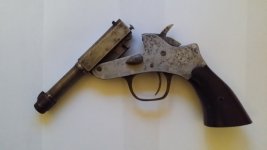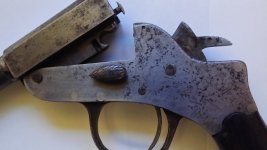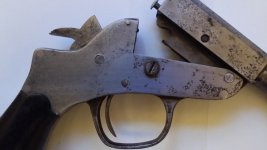My Father-in-law recently passed away and I received this from my Mother-in-law.
There are NO identifying marks on it except perhaps a very worn 22 on the left side of the frame. Tried to get a picture of it but it does not show up.
The frame appears to be steel, flat with-out decoration. The handle appears to be wood but may be Bakelite with wood finish.
The frame itself is three pieces, left side, right side and main frame from front of trigger guard to butt of hand grip.
Trying to upload 3 pictures but so far no luck.
Going to try just up-loading the pics separate.
Can anyone identify this? Appreciate any help you can give.
There are NO identifying marks on it except perhaps a very worn 22 on the left side of the frame. Tried to get a picture of it but it does not show up.
The frame appears to be steel, flat with-out decoration. The handle appears to be wood but may be Bakelite with wood finish.
The frame itself is three pieces, left side, right side and main frame from front of trigger guard to butt of hand grip.
Trying to upload 3 pictures but so far no luck.
Going to try just up-loading the pics separate.
Can anyone identify this? Appreciate any help you can give.



